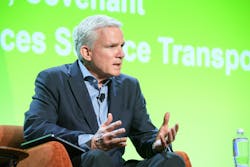What should fleets tell customers they’re doing for the climate?
Decarbonizing the entire trucking industry can seem impossible. Zero-emission technology still is developing and most of the U.S. lacks the infrastructure to support alternative fuels such as electric, hydrogen, and natural gas. But fleets have to start somewhere.
See also: Hydrogen’s future in trucking has steep hill to climb
Customers now want to know more about the carrier’s roadmap to sustainability, McLelland and other fleet leaders said during an executive roundtable discussion at this year's Advanced Clean Transportation Expo in Long Beach.
Craig Harper, chief sustainability officer at J.B. Hunt Transport, said he hopes the fueling infrastructure and zero-emission equipment can be built fast enough to keep up with his customers’ questions about what J.B. Hunt is doing to move freight with clean technologies.
Until then, the No. 5 for-hire 500 carrier launched Clean Transport. J.B. Hunt offers some customers carbon-offset credits equivalent to the emissions created by their shipments. The customers can select specific carbon credit projects. These include reforestation, forest management, regenerative agriculture, and clean power generation.
“This is a global problem,” Harper said. “We see carbon offsets as a way to take action now while we're all waiting on these other technologies to come online. Meanwhile, we're doing things to reduce emissions. Because first and foremost, all of us ought to have the goal to reduce the emissions—to eliminate the emissions.”
Getting started in sustainability
“We started disclosing things about policies that we had internally for years,” he said. “We didn’t know that we were getting bad scores from some of the rating agencies simply because we hadn’t made those public. You've got to be more transparent about that. Transparency teaches you a lot about yourself, and it also shows the outside world what you’re doing.”
Finding out what’s important to your stakeholders is a good place to start on sustainability, according to Debbie Kalish, director, enterprise sustainability and ESG initiatives, American Tire Distributors (No. 181 on FleetOwner 500: Private). She suggested doing a materiality assessment.
“That’s where you get the voice from your stakeholders because you need to be clear on what your stakeholders are looking for,” she said. “If they say that greenhouse gas is important, it probably is. If they say that water is important, it may be more important than you realize.”
See also: 'Clean' trucking is here to stay
Kalish added that it’s also essential to look at what a fleet’s partners are doing for sustainability. “Find out what’s important to them and then get aligned on how you work together,” she said. “Together, we can identify goals as well as solutions. If we do it in silos, we’re not going to get there—but if we all do it together, we create that groundswell.”
Like Kalish and Harper, Amazon’s Ari Silkey suggested finding your fleet’s challenges and goals. Then follow that up with transparency. “We hold ourselves to high accountability standards and publish reports on our sustainability impact on a regular basis,” the GM of North American surface transportation at Amazon said.
J.B. Hunt’s Harper added: “We've got a lot of stakeholders. The stakeholders are your investors, customers, employees, vendors, and the communities you serve. So when you look at the capital plan and you look at how you want to grow the company, you want to address all stakeholders. Once I was asked which one was most important? I said that’s like asking a parent of five kids which one you love the least. They’re all important, so you have to address all of them.”
Trucking’s future is still being written
Like other companies running private fleets, Amazon took control of its shipping—and thus major sustainability efforts—by creating its own fleet of tractor-trailers. The company debuted this year as No. 7 on the FleetOwner 500: Private list.
“We made strategic bets with both dollars and resources,” Silkey said. “There were portions of the market that we believed needed to be filled to drive the ecosystem forward.” Part of that is embracing new technologies and Amazon’s Climate Pledge Fund. “We realize that we are a large part of shipping needs and we also want to make material change in this ecosystem. We are taking large bets with resources, assets, and dollars.”
Added Covenant’s McLelland: “For a lot of companies, especially large companies like Amazon, a lot of the roadmap involved technology that has yet to be invented.”
Noting how many innovators and transportation leaders were gathered at the Long Beach Convention Center for the four-day ACT Expo, he cited companies such as Cummins for working on “some really disruptive stuff.”
“I just think it’s important to remember that some of our success hasn’t been invented yet.”
About the Author
Josh Fisher
Editor-in-Chief
Editor-in-Chief Josh Fisher has been with FleetOwner since 2017. He covers everything from modern fleet management to operational efficiency, artificial intelligence, autonomous trucking, alternative fuels and powertrains, regulations, and emerging transportation technology. Based in Maryland, he writes the Lane Shift Ahead column about the changing North American transportation landscape.





